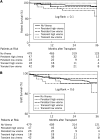Transient versus persistent BK viremia and long-term outcomes after kidney and kidney-pancreas transplantation
- PMID: 24408118
- PMCID: PMC3944774
- DOI: 10.2215/CJN.08420813
Transient versus persistent BK viremia and long-term outcomes after kidney and kidney-pancreas transplantation
Abstract
Background and objectives: The objective was to study the long-term impact of transient versus persistent BK viremia on kidney transplant outcomes.
Design, setting, participants, & measurements: In total, 609 recipients who underwent kidney transplant from 2007 to 2011 were screened at months 1-12 for the occurrence of polyomavirus BK viremia; 130 patients (21.7%) developed BK viremia during the first year post-transplant. BK viremia patients were classified according to duration of infection (more or less than 3 months), and BK viral loads (more or less than 10,000 copies/ml) were classified as transient low viremia (n=42), transient high viremia (n=18), persistent low viremia (n=23), and persistent high viremia (n=47). All patients were followed a median of 36 (3-66) months. The rates of BK polyomavirus-associated nephropathy, acute rejection, and 1-year graft function were compared with the polyomavirus BK-negative control group.
Results: Patient and graft survival were not significantly different among the groups. Graft function (creatinine; milligrams per deciliter) at 1 year was significantly worse in the persistent high viremia (1.75±0.6) and transient high viremia (1.85±0.7) groups compared with aviremic controls (1.47±0.4; P=0.01 and P=0.01, respectively). The incidence of BK polyomavirus-associated nephropathy was limited to the persistent high viremia group (1.3%, P<0.001). The transient high viremia (50%) and persistent high viremia (34%) groups showed significantly (P=0.01) increased incidence of acute rejection versus aviremic controls (21.5%), transient low viremia (19%), or persistent low viremia (17.3%) groups.
Conclusion: Low viral load BK viremia, either transient or persistent, was not associated with long-term transplant outcomes. Persistent high viremia was associated with a greater risk for BK polyomavirus-associated nephropathy and subsequent graft dysfunction. Although transient high viremia was not associated with BK polyomavirus-associated nephropathy, it was associated with worse graft function. These data support the role of surveillance for BK viremia after transplant.
Figures


References
-
- Hirsch HH, Brennan DC, Drachenberg CB, Ginevri F, Gordon J, Limaye AP, Mihatsch MJ, Nickeleit V, Ramos E, Randhawa P, Shapiro R, Steiger J, Suthanthiran M, Trofe J: Polyomavirus-associated nephropathy in renal transplantation: Interdisciplinary analyses and recommendations. Transplantation 79: 1277–1286, 2005 - PubMed
-
- Nickeleit V, Hirsch HH, Binet IF, Gudat F, Prince O, Dalquen P, Thiel G, Mihatsch MJ: Polyomavirus infection of renal allograft recipients: From latent infection to manifest disease. J Am Soc Nephrol 10: 1080–1089, 1999 - PubMed
-
- Ramos E, Drachenberg CB, Papadimitriou JC, Hamze O, Fink JC, Klassen DK, Drachenberg RC, Wiland A, Wali R, Cangro CB, Schweitzer E, Bartlett ST, Weir MR: Clinical course of polyoma virus nephropathy in 67 renal transplant patients. J Am Soc Nephrol 13: 2145–2151, 2002 - PubMed
-
- Hirsch HH, Knowles W, Dickenmann M, Passweg J, Klimkait T, Mihatsch MJ, Steiger J: Prospective study of polyomavirus type BK replication and nephropathy in renal-transplant recipients. N Engl J Med 347: 488–496, 2002 - PubMed
Publication types
MeSH terms
Substances
LinkOut - more resources
Full Text Sources
Other Literature Sources
Medical

